
Oss
is a town in the north of the Noord-Brabant province. It's the capital
of a large municipality, which also includes the
territories of the former municipalities of Megen, Haren en
Macharen and Berghem
(both
since 1994), Ravenstein (since 2003) and Lith (since 2011).
The
town of Oss was built in an area that was populated as early as 2000
B.C.. In 1399 Oss was granted city rights. Nothing of the
medieval town remains. It's a largely industrial town with a modernised
city centre.
Part of the municipality are the territories of the former County of Megen
and the Land van Ravenstein,
both lordships that retained their autonomy after the Reformation and were
catholic enclaves until 1800.
Oss
is een stad in het noorden van de provincie Noord-Brabant. Het is de
hoofdstad van een grote gemeente die ook het grondgebied van de
voormalige gemeenten Megen, Haren en Macharen en Berghem (beide sinds
1994), Ravenstein (sinds 2003) en Lith (sinds 2011) omvat.
De stad Oss is gebouwd in een gebied dat reeds in 2000 v. Chr. werd
bewoond. In 1399 kreeg Oss stadsrechten. Van de middeleeuwse stad
resteert niets. Tegenwoordig is Oss een grotendeels industriële stad
met een modern centrum.
Onderdeel van de gemeente zijn de territoria van het graafschap Megen en het Land van Ravenstein, beide heerlijkheden die na de Reformatie hun autonomie behielden en tot 1800 katholieke enclaves waren.
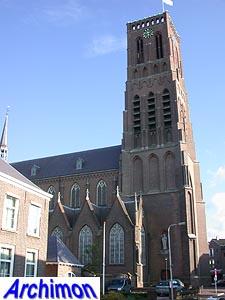
The main church of Oss is the O.L. Vrouw Onbevlekt Ontvangen, also known locally as Grote Kerk ('Great Church'). The Neo-Gothic basilica was designed by H.J. van Tulder and built in 1857-1859.
Location: Kerkstraat 15
De
belangrijkste kerk van Oss is de O.L. Vrouw Onbevlekt
Ontvangen, plaatselijk ook bekend als Grote Kerk. Deze
neogotische basiliek werd ontworpen door H.J. van Tulder en gebouwd in
1857-1859.
Locatie: Kerkstraat 15
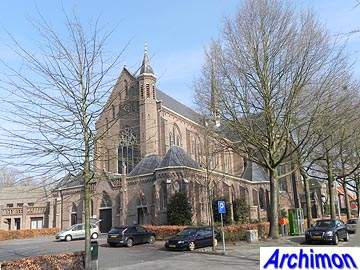
In 1921 the Heilig Hartkerk ('Sacred Heart church') was built, the second parish church of Oss. This late Neo-Gothic basilica was designed by W.Th. van Aalst.
Location: Kromstraat 107
In 1921 werd de Heilig Hartkerk gebouwd, de tweede parochiekerk van Oss. Deze laat-neogotische kruisbasiliek werd ontworpen door W.Th. van Aalst.
Locatie: Kromstraat 107
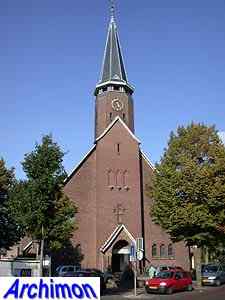
Just
east of the centre is a third catholic church, called the Heilige
Geest.
Orginally it was named St. Gerardus Majella, and locally
it's also called Visserskerk. It was designed in
Traditionalist style by Ed. Cuypers and built
in 1924-1925. The original choir was replaced by a large extension
designed by J. de Reus, in 1958-1959. In 1997 this part was demolished.
The church is
without a choir since.
Berghemseweg 4
Net
buiten het centrum staat nog een katholieke kerk, de Heilige
Geestkerk. Oorspronkelijk heette deze kerk St. Gerardus
Majella, en plaatselijk wordt zij ook wel Visserskerk genoemd. De kerk
werd in traditionalistische stijl ontworpen door Ed. Cuypers en gebouwd in 1924-1925. Het
oorspronkelijke koor werd in 1958-1959 vervangen door een grote
uitbreiding, ontworpen door J. de Reus. In 1997 werd dit deel gesloopt.
Sindsdien heeft de kerk geen koor meer.
Berghemseweg 4
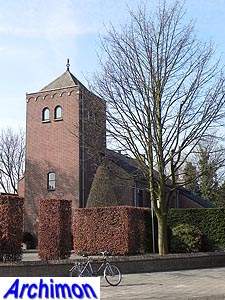
The Gereformeerde Kerk dates from 1950. The Traditionalist-style building was designed by B.W. Plooij and is now a house.
Location: Burgemeester van den Elzenlaan 22
De Gereformeerde Kerk stamt uit 1950. Het gebouw in traditionalistische stijl werd ontworpen door B.W. Plooij en is tegenwoordig een woning.
Locatie: Burgemeester van den Elzenlaan 22
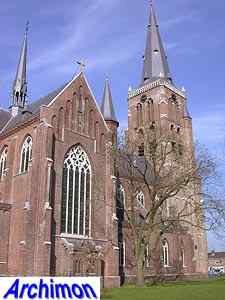
The St.
Willibrord in Berghem is a
cruciform basilica in neo-Gothic style, designed by
W.Th. van Aalst and
built in 1900-1903. It replaced a Gothic church, the tower of which,
although modified, was incorporated.
Location: St.Willibrordusstraat 40
De
St. Willibrord in Berghem is een kruisbasiliek
in neogotische stijl, ontworpen door W.Th. van Aalst en gebouwd in
1900-1903. Het verving een gotische kerk, waarvan de toren in el
gewijzigde vorm is behouden.
Locatie: St.Willibrordusstraat 40
Koolwijk
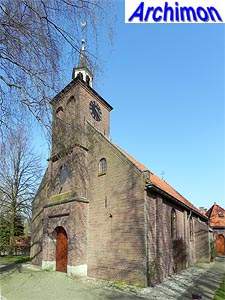
The St. Annakapel (St. Anne's Chapel) has its origins in a 16th-century chapel which in the 17th century served as a border church for catholics from Oss. The chapel was substantially rebuilt in 1936 by architect E.L. Jansen.
Location: Koolwijksestraat 5
De St. Annakapel heeft haar oorsprong in een 16e-eeuwse kapel die in de 17e eeuw dienst deed als grenskerk voor katholieken uit Oss. De kapel werd in 1936 ingrijpend verbouwd naar plannen door architect E.L. Jansen.
Locatie: Koolwijksestraat 5
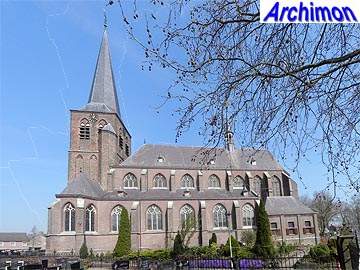
The St. Sebastianus is a basilica with a 14th-century tower and a 15th-century choir, both in Gothic style, with a Neo-Gothic nave built in 1907, designed by C. Franssen.
Location: 2 Rogstraat
De St. Sebastianus is een basiliek met een 14e eeuwse toren en een 15e eeuws koor, beiden in gotische stijl, alsmede een neogotisch schip uit 1907, ontwerpen door C. Franssen.
Locatie: Rogstraat 2
Huisseling
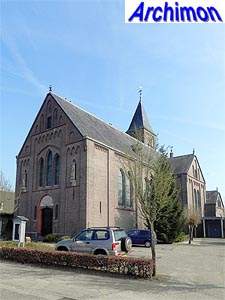
C. Franssen also designed the St. Lambertus, a one-aisled cruciform church in a combination of Neo-Gothic and Neo-Romanesque styles built in 1911-1912, replacing a 17th-century church with a medieval tower.
Location: Hamstraat 1
C. Franssen ontwierp ook de St. Lambertus, een eenbeukige kruiskerk in een combinatie van neogotische en neoromaanse stijl, gebouwd in 1911-1912 ter vervanging van een 17e-eeuwse kerk met een middeleeuwse toren.
Locatie: Hamstraat 1
Overlangel
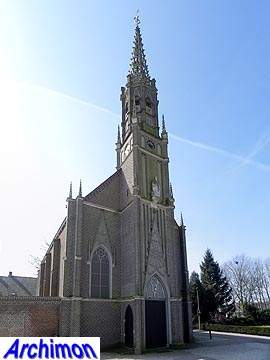
The St. Antonius Abt is a one-aisled church in early Neo-Gothic style with a remarkable cast iron spire. The church was designed by G. van Vogelpoel and was built in 1854-1855.
Location: Kerkstraat 20
De St. Antonius Abt is een eenbeukige kerk in vroeg-neogotische stijl met een bijzondere gietijzeren torenspits. De kerk werd ontworpen door G. van Vogelpoel en werd gebouwd in 1854-1855.
Locatie: Kerkstraat 20
Neerloon
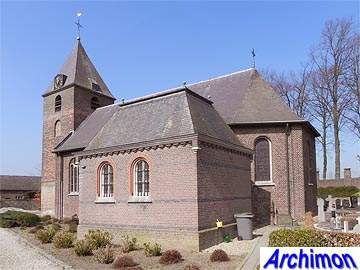 The
St. Victor comprises of a 13th-century tower, a one-aisled nave from 1821 with a
three-sided choir and a sacristy which was addded around 1910. The nave features
influences from the Renaissance, especially at the windows.
The
St. Victor comprises of a 13th-century tower, a one-aisled nave from 1821 with a
three-sided choir and a sacristy which was addded around 1910. The nave features
influences from the Renaissance, especially at the windows.
Location: Maasdijk 19
De St. Victor bestaat uit een 13e eeuwse toren, een uit 1821 stammend eenbeukig schip met driezijdig koor en een rond 1910 toergevoegde sacristie. Bij het schip zijn invloeden uit de renaissance toegepast, met name bij de vensters.
Locatie: Maasdijk 19
Ravenstein
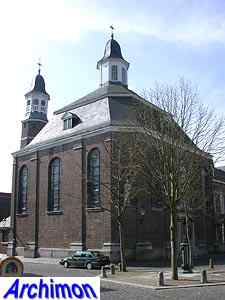
Ravenstein's autonomy made it one of only a few areas in the Netherlands were Roman Catholicism was not prohibited. The St. Luciakerk is a church in southern-German Baroque style, built in 1735.
Location: Sint Luciastraat 1
De
autonomie van Ravenstein maakte het tot een van de weinige gebieden in
Nederland waar de katholieke kerk niet was verboden. De St.
Luciakerk is een kerk in Zuid-Duitse barokstijl, gebouwd in
1735.
Locatie: Sint Luciastraat 1
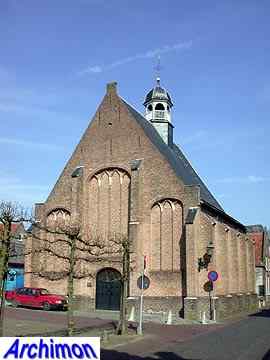
The reformed church dates from the period when the Republic was allowed to station a garrison in the town. The church, designed by Derick Bijl and built in 1641, was originally the garrison church. Note that the church, although not really Gothic, was designed in the Gothic tradition.
Location: Servetstraat 1
De
hervormde kerk dateert uit de periode toen de
Republiek een garnizoen mocht legeren in de stad. De kerk, ontworpen
door Derick Bijl en gebouwd in 1641, was oorspronkelijk garnizoenskerk.
Merk op dat de kerk, hoewel niet echt gotisch, werd ontworpen in de
gotische traditie.
Locatie: Servetstraat 1
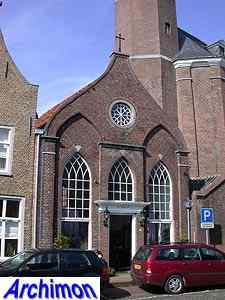
Nowadays
a shop, this building was
built as a congregation chapel in the 1840's.
It's a typical
example of early
neo-Gothic.
Location: Marktstraat 13
Tegenwoordig
een winkel, werd dit gebouw in de jaren 1840 gebouwd als een congregatiekapel.
Het is een typisch voorbeeld van vroege neogotiek.
Locatie: Marktstraat 13
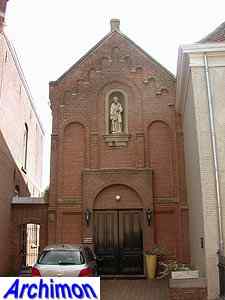
The St.
Josephkapel is the
chapel of the former Jesuite monastery. It was built in c. 1875 and was
originally hidden from view by the monastery. When the monastery was
demolished in 1900, the current facade was added to the chapel.
Location: Sint Luciastraat 5
De
St. Josephkapel is de kapel van het voormalige
jezuïetenklooster. De kapel werd gebouwd in ca. 1875 en was
oorspronkelijk aan het zicht onttrokken door het klooster. Toen het
klooster in 1900 werd afgebroken kreeg de kapel de huidige voorgevel.
Locatie: Sint Luciastraat 5
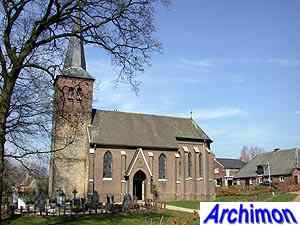
The St.
Jan is a small Neo-Gothic
church from 1869. It replaced a medieval church of which the
11th-century Romanesque
tower remains, albeit heightened with one
storey. This tower is the oldest in the province of Noord-Brabant.
Location: Sint Jansstraat 2
De St. Jan
is een kleine neogotische kerk uit 1869. Het gebouw verving een
middeleeuwse kerk waarvan de 11e-eeuwse romaanse toren is behouden, zij
het verhoogd met een verdieping. Deze toren is de oudste in de
provincie Noord-Brabant.
Locatie: Sint Jansstraat 2
Demen
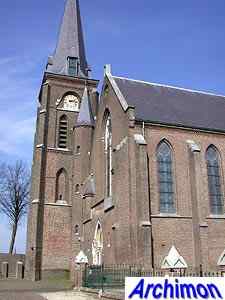
The St. Willibrordus is a Neo-Gothic church from 1857-1860 and one of P.J.H. Cuypers' early designs. The 15th-century tower of a predecessor was preserved, but in 1890 restored in neo-Gothic style by the same architect.
Location: Maasdijk 69
De
St. Willibrordus is een neogotische kerk uit
1857-1860 en is een vroeg ontwerpen van P.J.H. Cuypers. De
15e-eeuwse toren van de voorganger werd behouden, maar werd in 1890
neogotische stijl gerestaureerd door dezelfde architect.
Locatie: Maasdijk 69
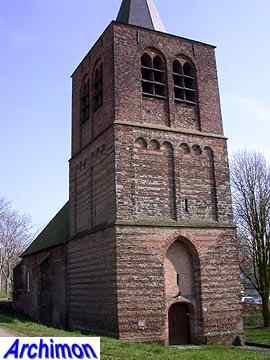
The
former reformed church
of Dieden is
a picturesque but rather neglected Romanesque building. Unlike other
villages of the Ravenstein municipality, Dieden never was part of the
catholic enclave but fell under the jurisdiction of the province of
Gelderland instead, which explains why the medieval church became a
protestant one.
Location: Maasdijk 79
De
voormalige hervormde kerk van Dieden is een
schilderachtig, maar nogal verwaarloosd romaans gebouw. In
tegenstelling tot de andere dorpen van de voormalige gemeente
Ravenstein, maakte Dieden nooit deel uit van de katholieke enclave,
maar viel onder de jurisdictie van de provincie Gelderland, hetgeen
verklaart waarom de middeleeuwse kerk protestants bleef.
Locatie: Maasdijk 79
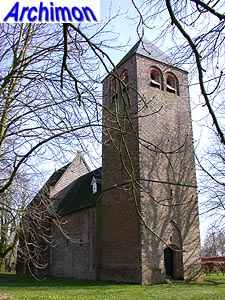
The former St. Michaël in Dennenburg is a church with a Romanesque tower and nave and a Gothic choir.
Location: Hoogstraat 36
De
voormalige St. Michaël in Dennenburg is een kerk met een romaanse
toren en schip en een gotisch koor.
Locatie: Hoogstraat 36
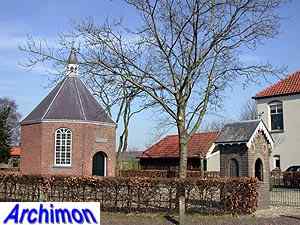
Deursen's
location in the
autonomous Land van Ravenstein guaranteed religious freedom to the
catholics. This small octagonal chapel, named H.H. Antonius
en
Rochuskapel and built in 1745-1747, attracted many pilgrims
from
outside the region.
Location: Rondestraat 26
De
ligging van Deursen in de autonome Land van Ravenstein garandeerde
vrijheid van godsdienst voor de katholieken. Deze kleine
achthoekige kapel, genaamd H.H. Antonius en Rochuskapel
en gebouwd in 1745-1747, trok vele pelgrims van buiten de regio.
Locatie: Rondestraat 26
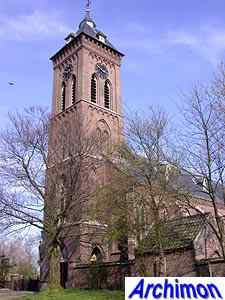
The St. Vincentiuskerk is a Neo-Gothic church designed by C. van Dijk and built in 1874-1877.
Location: Langstraat 16
De
St. Vincentiuskerk is een neogotische kerk,
ontworpen door C. van Dijk en gebouwd in 1874-1877.
Locatie: Langstraat 16
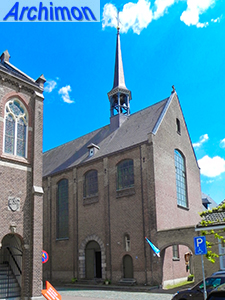
The Franciscan monastery was founded in 1645 by friars expelled from 's-Hertogenbosch. The church was built in 1670 and is in a modest Baroque style.
Location: Kloosterstraat 6
Het Franciscanerklooster werd in 1645 gesticht door uit 's-Hertogenbosch verdreven broeders. De kerk is gebouwd in 1670 en heeft een bescheiden barokke stijl.
Locatie: Kloosterstraat 6
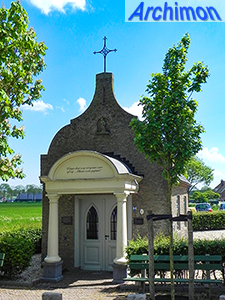
The chapel O.L. Vrouw van Zeven Smarten ('Our Lady of the Seven Sorrows') was built in 1733 a bit south of Megen.
Location: Kapelstraat/Megensedijk
De kapel O.L. Vrouw van Zeven Smarten werd gebouwd in 1733 iets ten zuiden van Megen.
Locatie: Kapelstraat/Megensedijk
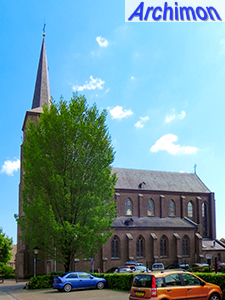 The
St. Servatius is a basilica in neo-Gothic style, designed by H.C. Dobbe and
built in 1870-1872.
The
St. Servatius is a basilica in neo-Gothic style, designed by H.C. Dobbe and
built in 1870-1872. Location: Schoolstraat 1
De St. Servatius is een basiliek in neogotische stijl, ontworpen door H.C. Dobbe en gebouwd in 1870-1872.
Locatie: Schoolstraat 1
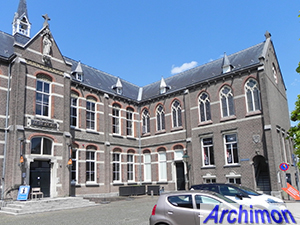 The
seminary
was built in 1884 and is in neo-Gothic style, with a chapel recognized by
its pointed windows. The building was designed by
E.J. Margry.
The
seminary
was built in 1884 and is in neo-Gothic style, with a chapel recognized by
its pointed windows. The building was designed by
E.J. Margry. Location: Everardusplein 1
Het seminarie werd gebouwd in 1884 en is in neogotische stijl, met een kapel die herkenbaar is door de spitsvensters. Het gebouw is ontworpen door E.J. Margry.
Locatie: Everardusplein 1
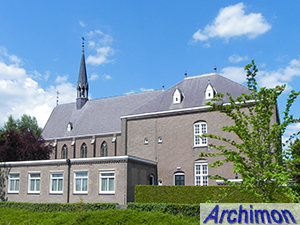 The clarist
convent St. Josephsberg was founded in 1721 by Poor Clares who were expelled
from Boxtel in 1717. The convent was built on the site of the castle of the
counts of Megen which had been demolished in 1610. The neo-Gothic chapel was
built in 1896-1898 and was designed by
N.J.H. van Groenendael.
The clarist
convent St. Josephsberg was founded in 1721 by Poor Clares who were expelled
from Boxtel in 1717. The convent was built on the site of the castle of the
counts of Megen which had been demolished in 1610. The neo-Gothic chapel was
built in 1896-1898 and was designed by
N.J.H. van Groenendael. Location: Clarissenstraat 2
Het Clarissenklooster St. Josephsberg is in 1721 gesticht door Clarissen die in 1717 uit Boxtel waren verdreven. Het klooster is gebouwd op de plaats van het in 1610 gesloopte kasteel van de graven van Megen. De neogotische kapel is gebouwd in 1896-1898 en is ontworpen door N.J.H. van Groenendaal.
Locatie: Clarissenstraat 2
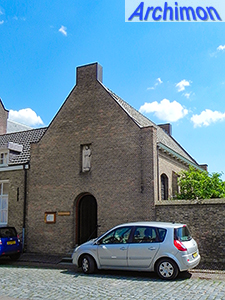 The
burial chapel is a small chapel in Traditionalist style, designed by
architect friar M. Zijlstra. It was built in 1953-1954 just outside the
monastery for the remains of friar Everardus Witte, replacing his much
visited grave within the monastery walls.
The
burial chapel is a small chapel in Traditionalist style, designed by
architect friar M. Zijlstra. It was built in 1953-1954 just outside the
monastery for the remains of friar Everardus Witte, replacing his much
visited grave within the monastery walls. Location: Kloosterstraat 6
De grafkapel is een kleine kapel in traditionalistische stijl, ontworpen door architect frater M. Zijlstra. Het werd gebouwd in 1953-1954 net buiten het klooster voor de stoffelijke resten van broeder Everardus Witte, ter vervanging van zijn veelbezochte graf binnen de kloostermuren.
Locatie: Kloosterstraat 6
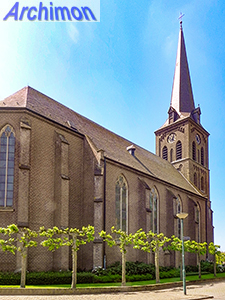 The
St. Petrus'
Banden is an aisleless church in neo-Gothic style, designed by
H.J. van Tulder ands built in 1862-1867.
The
St. Petrus'
Banden is an aisleless church in neo-Gothic style, designed by
H.J. van Tulder ands built in 1862-1867. Location: Kerkstraat 3
De St. Petrus' Banden is een zaalkerk in neogotische stijl, ontworpen door H.J. van Tulder en gebouwd in 1862-1867.
Locatie: Kerkstraat 3
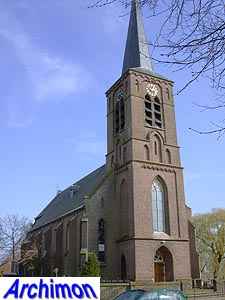
The St. Lambertus of Haren is a neo-Gothic basilica built in 1867-1868. It was designed by H.J. van Tulder and replaced a Romanesque church.
Location: Kerkplein 7
De
St. Lambertus van Haren is een neogotische
basiliek, gebouwd in 1867-1868. De kerk werd ontworpen door H.J .van
Tulder en verving een romaanse kerk.
Locatie: Kerkplein 7